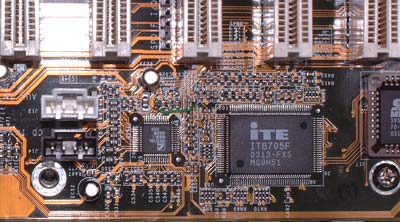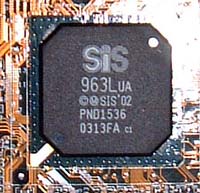DFI 748-AL: First Look at SiS 748
by Wesley Fink on August 30, 2003 12:00 AM EST- Posted in
- Motherboards
DFI 748-AL: Basic Features
| Motherboard Specifications | |
| CPU Interface | Socket-462 |
| Chipset | SiS 748 North Bridge SiS 963L South Bridge |
| Bus Speeds | up to 232MHz (in 1MHz increments) |
| Core Voltages Supported | up to 1.850V (in 0.025V increments) |
| AGP Voltages Supported | up to 1.8V (in 0.1V increments) |
| DRAM Voltages Supported | up to 2.8V (in 0.1V increments) |
| Chipset Voltage | 1.8V to 2.1V in 0.1V increments |
| CPU Multiplier Ratios | 5X to 21X |
| Memory Slots | 3 x 184-pin DDR DIMM Slots |
| Expansion Slots | 1 AGP 8X Slot 5 PCI Slots |
| Onboard IDE RAID | Standard ATA 133/100/66 Supporting up to 4 IDE devices |
| Onboard USB 2.0/IEEE-1394 | 6 USB 2.0 ports supported by 964L No FireWire |
| Onboard LAN | SiS 900 10/100 LAN |
| Onboard Audio | AC'97 2.2 compliant 5.1 codec |
| Onboard Serial ATA | None |
| BIOS Revision | Evaluation BIOS (8/08/2003) |
The DFI 748-AL is a good example of how much has been added to motherboard features in the last few years. With on-board 10/100 LAN, 5.1 channel audio, 6 USB 2.0 ports, ATA133 IDE support, and 8X AGP, the 748-AL would have been considered loaded just a short time ago. Now, compared to the feature-rich boards in the market, it is considered a standard or value board. Nothing you really need is absent from the 748 unless you need firewire, and that can be added with an add-on card.
Since our test board was an Engineering Sample, we cannot be sure exactly what accessories will ship with the release 748-AL, but we would suspect you will receive IDE cables, floppy cable, a CD with drivers, possibly a USB bracket, and not much else. You shouldn’t expect more than basics with a board designed to sell for a value price.
The DFI is anything but a value board in the tweaking and overclocking options. The ranges DFI has provided are the best we have seen on any announced SiS 748 motherboard. It is also the only 748 to provide CPU multiplier selection in BIOS — an important feature for many AMD users.

DFI has included an AC’97 compliant 6-channel audio on the 748-AL. Specifications on the website show a Realtek codec used, but our Engineering Sample was equipped with the cMedia codec used on the LANParty series. Both the Realtek and cMedia are AC’97 complaint, so either would meet specifications. There is also a connector for an optional SPDIF bracket.

On-board LAN is provided by SiS 900 Ethernet code in the 963L southbridge. The SiS 900 is a 10/100 Ethernet connection.

DFI has included 2 USB 2.0 ports on the I/O panel with headers for 4 additional USB 2 ports on the motherboard, for a total of 6 USB 2.0 ports provided by the 748/963L chipset. With SiS, VIA, and nVidia all providing extensive USB 2.0 support in their latest chipsets, this has become a standard feature.

The 748-AL uses the standard ATX ports configuration and can be used with the standard plates that come with ATX cases. This includes PS/2 mouse and keyboard ports, two USB 2.0 ports, one 10/100 LAN port, two serial ports, one parallel port, game port, and Mic In, Line In, and Line Out, which are controlled by the onboard sound. There are no Firewire ports.
Sis has been a pioneer in high-speed links between north and south bridges, and we find the 1GB Mutiol connection used on the 748-AL. Hyperstreaming, which was discussed in our look at the 748 chipset, is also a feature of the 748/963L chipset. Both are features designed to improve speed of the motherboard.










22 Comments
View All Comments
JAGedlion - Saturday, August 30, 2003 - link
... The DFI 748-AL has 5 IDE ... I see you are referring to PCI slots, can they be called IDE slots too?Anonymous User - Saturday, August 30, 2003 - link
wonder how far would the FSB go if the vdd was pushed into its max. i guess it would definetly go beyond 212MHz, maybe you should have decreased the multiplier.In fact, today I ran a few benchmarks with my epox 8k5a2 KT333 and reached as far as 215. pushing it further the AGP bus became bottleneck and i was using ATI's oldskool's rage128. it amazes me how come brand new hardware can't handle even 72MHz agp clock, whereas my 4 years old card handles 86MHz. in FSB200 (agp/pci 80/40) i'm not experiencing any staiblity issues burning it with prime or cpuburnK7 even 3days. odd
Anonymous User - Saturday, August 30, 2003 - link
One can easily see from his comment that Jeff7181 doesn't know much about these things, but still thinks he's got an argument. Anandtech crew are admirably wasting their efforts in trying to reason with such people.About the board. Two phase and no 12V connector drives me away from it just by looking at it.
About SiS. They have nice chipsets, but the motherboard makers skimp on the design because they use the SiS chipsets for another market than they do for instance with their nForce2 boards. That's unfortunate since I would rather go with SiS drivers than nVidias. Performance is often overemphasised when reliability and ease of use becomes a second thought for many buyers.
Anonymous User - Saturday, August 30, 2003 - link
May i make a helpful suggestion/request for the next (or even current) review? Could you please post the ranges of the bois setting instead of just the maximums? for example, instead of saying "cpu voltage in the full range, up to 1.85v" could you specify exactly what that range is? like 1.1-1.85v? I know the nForce boards can do this, but I'm unclear about 748 boards.I'm personally looking at this board for a home theater PC that I'm going to try and underclock the CPU and see if i can get it to run without a fan and still be fast enough to play DVD's... because of this, I'd like to know the minimum voltage you can run the CPU at, and I don't find that in a lot of reviews. Just that little change would satisfy the speed freaks as well as us quiet freaks.
just a suggestion...
Evan Lieb - Saturday, August 30, 2003 - link
Jeff,As Wesley mentioned and as I said before, Epox and ASUS' nForce2 Ultra 400 motherboards perform nearly exactly the same as the Gigabyte and DFI nForce2 Ultra 400 motherboards (and others) we use in AMD motherboard reviews. I have both boards in my labs and have decided not to send them to Wesley for retesting because I wouldn't want to waste his time with something like that.
Again, we have tested ASUS and Epox boards before and found them to perform within about 1% of other nForce Ultra 400 motherboards. We changed our testbed and made sure a few good nForce2 Ultra 400 motherboards we added for comparison to non-NVIDIA chipsets.
We may add those very popular Epox and ASUS boards to an nForce2 roundup of some type. But for a SiS 748 review like this one, the boards we used were perfectly adequate.
Dennis Travis - Saturday, August 30, 2003 - link
Very good review Wes, keep up the great work.Wesley Fink - Saturday, August 30, 2003 - link
Jeff7181 -I'm asking, Jeff, that you Please give me a break. I took over AMD about 6 weeks ago, and all Athlon reviews prior to that were done by Evan. Evan has answered here, on every post you have made on every AMD review, that the performance difference for Ultra 400 versions was very small, which is why he chose NOT to review the Ultra 400 updates of the boards you mention. The results of our tests of the regular nForce2 versions of the boards you mention are in our database. We also have the two top Ultra 400 performers - the DFI NFII Ultra LANParty and Gigabyte 7NNXP with UPDATED benchmarks in our tests for your comparison. If you recall, we also changed our video cards and benchmark suite recently, and we are finally accumulating a useful database of new benchmark data.
My point, Jeff, is I do NOT have access to the motherboards you mention and cannot add them to our database. I am doing my best to provide useful information to AMD fans, but I cannot provide what you ask. My next AMD review is a Ahtlon64 Preview, and with the launch only 3 weeks away it just doesn't make good use of review time to request an Asus A7N8X Deluxe and retest it.
If you can please show a little patience we will do our best to provide the kind of information you are looking for in the future.
Thank you.
Wesley Fink - Saturday, August 30, 2003 - link
Charts are in Flash because it uses less bandwidth than any of the alternatives. With over 3300 articles and reviews on-line plus News and Forums, bandwidth is a very important subject to a site like AnandTech.Anonymous User - Saturday, August 30, 2003 - link
Why are the charts in Flash? A simple jpg or gif would do.Jeff7181 - Saturday, August 30, 2003 - link
Again I ask, where the hell is the comparisons to the motherboards we all know? The A7N8X Deluxe, NF-7, 8RDA+. And what's with the cheesy title? Can SIS outperform nVidia's nForce2? I could have answered that without even testing them! Geeze... what's going on at AnandTech? These reviews suck!